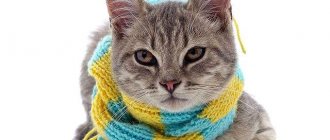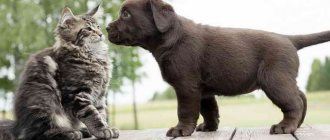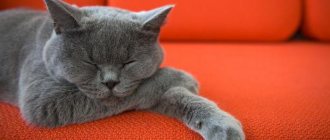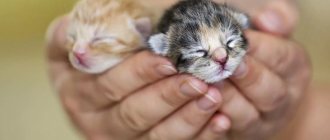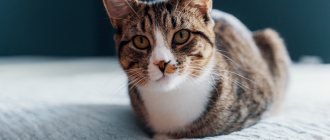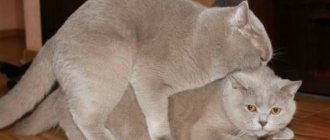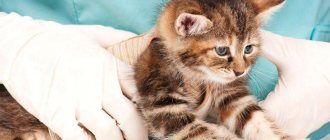Thousands of years side by side with man
Until recently, scientists believed that the domestication of cats began nine and a half thousand years ago. However, a groundbreaking new study published in the journal Science theorizes that the history and origins of cats as human companions goes back much further, to about 12,000 years ago. After analyzing the genes of 79 domestic cats and their wild ancestors, scientists concluded that modern cats descended from the same species: Felis silvestris (wild cat). Their domestication occurred in the Middle East in the Fertile Crescent region along the Tigris and Euphrates rivers, which includes Iraq, Israel and Lebanon.
It is known that many peoples have worshiped cats for thousands of years, considering them royal animals, adorning them with expensive necklaces and even mummifying them after death. The ancient Egyptians elevated cats to a cult and revered them as sacred animals (the most famous is the cat goddess Bastet). Apparently, this is why our furry beauties expect our complete worship.
According to David Zaks, writing for Smithsonian, the importance of this revised timeline is that it highlights that cats have been helping people for almost as long as dogs, just in a different capacity.
Non-traditional versions
Mammals of the cat family have always been considered mysterious and enigmatic animals. Therefore, people made different guesses about where cats came from.
Most versions were fantastic:
- biblical;
- alien;
- Egyptian;
- lunar.
There is a legend in the Bible about the appearance of the first cats. When God decided to destroy all of humanity and sent a forty-day rainstorm to Earth, he saved the righteous Noah and his entire family. Domestic cats did not yet exist at that time. The old man built an ark, on which he collected a pair of all the animals and birds, a sufficient amount of food and water for food.
But rodents began to destroy these reserves, people could die of hunger. God saw this and decided to save the last representatives of humanity. In a dream, he appeared to Noah and ordered him to rub the lion's nose. The old man obeyed his creator and stroked the predator. A cat appeared next to the animal. She could not kill the rodents, since there were only two of each type. But the pet drove them away from grain crops and vegetables.
Cats were highly revered by the ancient Egyptians. They elevated the animal to the rank of saints and depicted them on tombs, walls of temples and pyramids. There is a version according to which pets flew from other planets to this country. These were hairless cats that maintained a telepathic - mental - connection with the inhabitants of Ancient Egypt.
What vaccinations do cats need? (part 3)
The myth states that one such animal was walking through the forest and met a wild shaggy mammal. The predators fell in love with each other, and the alien cat did not return to her homeland, she stayed with her partner. The family had fluffy kittens, which became the ancestors of modern animals.
The Egyptian pharaoh Akhenaten considered himself the son of the Sun God, and called cats his half-brothers. Now this version seems unreal, but even Pythagoras claimed that it was true. And Plato said that the Moon is the place where the first cats appeared. That is why the phases of the luminary influence their behavior, and the animals themselves see well in the dark and are nocturnal.
St. Augustine called the birthplace of pets the stars to which the human soul flies after death. God sent the cat on its way back and gave it the ability to see and communicate with spirits. Therefore, predators can sit for hours, peering into the void or fighting invisible opponents.
Still wild
As Gwynne Guilford writes in The Atlantic, cat genome expert Wes Warren explains that “cats, unlike dogs, are only half domesticated.” According to Warren, the domestication of cats began with the transition of humans to an agricultural society. It was a win-win situation. Farmers needed cats to keep rodents away from their barns, and cats needed a reliable source of food, which came from captured rodents and treats from farmers.
So, feed the cat and he will become your friend forever?
Maybe it won't, says Guilford. As cat genome studies confirm, one of the main differences in the domestication of dogs and cats is that the latter did not become completely dependent on humans for food. “Cats have retained the widest acoustic range of all predators, allowing them to hear the movements of their prey,” the author writes. “They have not lost the ability to see at night and digest foods rich in proteins and fats.” So, despite the fact that cats prefer ready-made food presented by a person, if necessary, they can go and hunt.
History of the breed in Russia
Work aimed at restoring and significantly improving the British Shorthair cat was continued only after the Second World War ended. Initially, representatives of this breed were used in crossing with Russian Blue cats, Persian and Carthusian cats, which were popular at that time.
Somewhat later, the British were classified as an independent breed, after which they appeared in our country. The very first purebred British cats were brought to Russia in the seventies of the last century. During the first few years, domestic breeders highly appreciated all the advantages of this breed, so now the “British” have been able to push aside even the Siamese and Persian cats in terms of popularity.
The first epoch-making felinological exhibition is considered to be the display of pedigree animals in the Moscow equestrian complex “Bitsa”, which was held in the spring of 1987, but without the participation of domestic purebred British shorthaired domestic cats.
The fact is that the very first “Britons”, obtained under Russian breeding conditions, only in their external characteristics resembled the pedigree British Shorthair, which was due to the use of European Shorthair and Persian cats in crossing.
Among other things, the British cats that were exported from the Czech Republic and eastern Germany were also very far from perfect, and therefore did not belong to the category of first-class representatives of the breed.
Not everyone likes cats
The history of cats contains several examples of "cool" attitudes, especially in the Middle Ages. Although their outstanding hunting skills made them popular animals, some were wary of their unerring and silent attack on prey. Some peoples even declared cats to be “devilish” animals. And the impossibility of complete domestication also, of course, played against them.
This wary attitude towards furry creatures continued during the era of witch hunts in America - not the best time to be born a cat! For example, black cats were unfairly considered vicious creatures that help their owners in dark affairs. Unfortunately, this superstition still exists, but more and more people are convinced that black cats are no worse than their relatives of other colors. Fortunately, even in those dark times, not everyone hated these graceful animals. As previously noted, farmers and villagers appreciated their good work in hunting mice, which kept the barns stocked. And in monasteries they were kept as pets.
In fact, according to the BBC, most of the legendary animals lived in medieval England. A young man named Richard (Dick) Whittington came to London looking for work. He bought a cat to get rid of mice in his attic room. One day, a wealthy merchant for whom Whittington worked invited his servants to earn extra money by sending some goods for sale on a ship sailing to overseas countries. Whittington had nothing to give except a cat. Fortunately for him, she caught all the rats on the ship, and when the ship landed on the shores of an overseas country, her king bought Whittington’s cat for a lot of money. Despite the fact that the story about Dick Whittington has no confirmation, this cat became the most famous in England.
The appearance of animals in Russia
These furry animals appeared in Russia only in the 11th century. A large number of them were found in port cities, so it was believed that they were brought on trade ships by eastern merchants.
The most ancient remains were found near Odessa. In the cities of the Baltic states, individual individuals appeared in the 5th–6th centuries, in the Volga region - in the 7th–9th centuries. The cat was the guardian of the hearth and its symbol. It was also considered by the pagan Slavs to be a guide of the soul to another world.
With the adoption of Christianity, Saint Blaise becomes the patron saint of cats. Many believe that the popular nickname Vaska came from here.
Initially, only royalty and boyars could afford to keep pets, since the majority of the population simply could not afford them.
Peter the Great brought Vasily the cat from Holland. There lived a pet in the royal palace. A royal decree was issued specifically for this purpose.
Very soon these animals became very popular. Breeding them has become a common activity. Many churches kept cats to protect their grain supplies. A large fine was imposed for attempting to steal a pet. In the 18th century, cats spread everywhere in Russia. A domestic cat becomes a favorite for its owners. At this time, signs and beliefs associated with these animals appeared.
Purposeful breeding of new breeds began in 1800. Decorative species were specially bred for the exhibition in London. Visitors to the exhibition were especially impressed by the Siamese and Persian cats. In the modern world, geneticists are working on developing other breeds of pets with different colors, body sizes and fur types.
You can find out more about the history of the appearance of cats below.
Modern cats
World leaders with an affinity for cats played a role in turning these animals into beloved pets. Winston Churchill, British Prime Minister during World War II and an animal lover, famously kept pets at his Chartwell country estate and at his official residence. In America, the first cats in the White House were Abraham Lincoln's favorites, Tabby and Dixie. It is said that President Lincoln loved cats so much that he even picked up stray animals during his presidential term in Washington.
Although you're unlikely to find a police cat or a rescue cat, they help modern society more than you might think, largely due to their top-notch hunting instincts. Cats were even “drafted” into the army to preserve food from rodents and, accordingly, save soldiers from hunger and disease, reports the PetMD portal.
Reflecting on the long and rich history of cats as pets, one question cannot be answered: did humans domesticate cats, or did they choose to live with humans? Both questions can be answered in the affirmative. There is a special bond between cat owners and their pets, and people who love cats happily worship their four-legged friends because the love they receive in return makes their hard work (and persistence) worth it.
Myths, legends and original versions of the origin of cats and their appearance on Earth
Due to their attractive appearance, independent character and special manner of communicating with humans, cats have long been attributed with unusual properties and otherworldly origins.
Many believe that these animals can predict natural disasters and heal their owners. Their ability to group in a jump and almost always land on their paws never ceases to amaze. Where could cats come from?
The Myth of Noah's Ark
Interestingly, according to legend, there were no cats on the ship into which God ordered Noah to take a pair from each type of animal. According to the Old Church Slavonic apocrypha, the devil got into the ark, turning into a mouse, and tried to gnaw its bottom, but after Noah’s prayer, God sent him a cat and a female cat, who killed the pest. According to another version, these animals appeared from the nostrils of a lion when Noah stroked him.
The Divine Origin of Ancient Cats
In Ancient Egypt, cats were attributed to divine origin and, accordingly, were given corresponding significance. The sacred role of representatives of the cat family in ancient Egyptian society is evidenced by numerous frescoes and statues found during excavations. Pharaoh Akhenaten, the husband of the famous Nefertiti, considered himself the son of the sun god, and all cats and cats - his brothers and sisters.
Bastet
It is known that it was customary for the ancient Egyptians to depict the goddess of fertility and hearth, as well as fun and joy, Bastet, in the form of a woman with a cat's head or a cat. In the city of Bubastis, a temple was built in honor of this goddess, and her high priest bore the title of great healer. Bastet, like a cat, sometimes became ferocious and turned into the lioness goddess Sekhmet, who was distinguished by incredible cruelty, but also patronized warriors and healers. It is known about magnificent holidays in honor of Bastet, when pilgrims gathered in Bubastis, where they drank a lot of wine, played musical instruments and sang.
If there was a fire in the house, cats were rescued first as God's messengers, and then the rest of the property. After death, pets were embalmed and buried in richly decorated caskets, but most importantly, mourning was observed. Not to mention killing, the ancient Egyptians were subject to severe punishment and public condemnation for beatings and disrespectful treatment of these animals.
Cats are messengers of extraterrestrial civilization
Ancient Egyptian mythology gave rise to a version about the alien origin of cats. Its adherents believe that a hairless cat flew to Ancient Egypt from another planet, which spoke human language and mentally communicated with people. Having met and fallen in love with a wild steppe cat in the forest, she decided to stay on this planet and acquired offspring from her beloved, from whom all domestic cats subsequently descended. Interestingly, astronauts collected small coin-like formations on the Moon. It turned out that their composition is similar to cat feces.
According to Plotinus (not to be confused with Plato), cats came to earth from the Moon. In the collection “Enneads,” he argues his point of view by the fact that these animals, thanks to their excellent vision, are well oriented in the dark, their behavior depends on the phases of the satellite, and they like to walk at night. As a joke, cat owners agree with this version, especially when they are trying to calm down their cats who are acting up at night.
In the work of St. Augustine, a hypothesis was put forward that cats appeared on earth straight from distant stars. It is believed that God endowed them with the ability to move freely between the earthly and other worlds in order to accompany the souls of the dead to a new location and convey messages from them to living people. Some esotericists today believe that cats see the supernatural and can communicate with spirits.
History of domestication
East Siberian Laika (world champion 2009)
Not all types of animals are able to get along with humans, only a few were able to overcome the fear of people ([ source not specified 1000 days
]).
Different peoples tamed many of the most unexpected animals - antelopes, cranes, ostriches, pythons, and even crocodiles. Some scientists believe that primitive people even kept in captivity and domesticated megatherians (now extinct giant sloths) ([ source unspecified 383 days
]) and cave bears. And the Carthaginian commander Hannibal in the wars with the Romans at the end of the 3rd century BC. e. used war elephants.
Ayrshire cow
However, taming does not mean domesticating. The number of species of truly domesticated animals is very small - no more than 25. For domestication, it is necessary that an animal kept in captivity regularly bear offspring, that is, an agrocenosis or other artificial landscape has become a normal, familiar habitat for it. Only then can we engage in selection and, preserving individuals with the most valuable properties for humans, after many centuries we can obtain not just a domesticated animal, but a real pet. For example, in ancient times, at the courts of the rulers of Syria, India, Central Asia, and even Europe, cheetahs were often kept, valued for their beauty and excellent hunting qualities. History knows two examples when tame cheetahs belonged to great people: one - Genghis Khan, the other - Charlemagne. However, tamed cheetahs did not become domesticated.
The wolf became the first companion of man, having “attached” to him in the Stone Age (10-15 thousand years ago). Geneticists have found that wolves were first domesticated by humans in South Asia. Thus, the domestic dog evolved from domesticated wolves and, possibly, jackals.
Rooster
The friendship between man and sheep and goats lasts almost as long (at least 10 thousand years). The ancestor of sheep was the mountain sheep - mouflon, which lived in Southern Europe and Western Asia. As a result of crossing and careful selection, man created more than 150 breeds of domestic sheep, now only vaguely reminiscent of the wild ancestor. Goats descend from the bearded or bezoar goat, an inhabitant of the same areas as the mouflon. The number of breeds of domestic goats is small, but they are very diverse: Angora with excellent wool, Swiss dairy; small Cameroonians, excellent tree climbers, etc.
The greatest benefit to humans came from the domestication of the aurochs, the ancestor of modern cows. More recently, wild aurochs were found in Europe, North Africa, Asia Minor and the Caucasus. The last female aurochs on Earth was killed in Poland, in the forests of Mazovia, in 1627.
7.5 thousand years ago, man domesticated the Asian buffalo, a strong and dangerous animal. Now in hot countries they are not only a source of meat and skins, but also an irreplaceable traction force.
The horse was domesticated relatively recently - 5-6 thousand years ago. Its ancestor was the now exterminated tarpan, which felt at ease in the steppes of Eurasia. However, some scientists suggest that the horse's pedigree begins with a wild horse, called the Przewalski's horse.
A pigeon named Cher Ami, who served in the US Army at the beginning of the 20th century
During the transition of man to a sedentary lifestyle (about 10 thousand years ago) and with the beginning of the development of agriculture, when the first settlements and barns appeared in which grain reserves were stored, the first domestic cats appeared. The domestication of the cat occurred in the Middle East through the domestication of the wild Middle Eastern (aka Libyan or Nubian) cat, and all 600 million domestic cats living on Earth today are descendants of wild Middle Eastern (Libyan) cats domesticated in the Fertile Crescent region.
The history of poultry is also significant: about 5 thousand years ago, chickens descended from the bank and red chickens of South and Southeast Asia, and geese, descendants of the wild gray goose, were domesticated. 3-4 thousand years ago, ducks were domesticated simultaneously in Europe and China, and guinea fowl in West Africa.
To create a variety of breeds, man used not only birds and mammals, but also some invertebrate animals, the most important of which are the honey bee and the silkworm. This happened quite a long time ago - about 5 thousand years ago.
Experiments in the field of domestication are still ongoing. Breeders are working with elk and antelopes, red deer and musk oxen, sables, minks and many other fur-bearing animals.
Taking care of appearance and health
Any animal that comes under human care needs some care, and the domestic cat is no exception.
- Grooming is a regular procedure. If you have a domestic long-haired cat, 2-3 brushings a week are enough; if your pet has short fur, once will be enough.
- Water procedures – if the cat’s fur is dirty, the cat needs to be bathed using a special shampoo.
- Nail trimming – the procedure is carried out once a month, cutting the nail by 2 mm. You can skip this step if you give your pet a scratching post.
- Care for the eyes and ears - they are regularly examined and dirt is removed. The ears are cleaned with a cotton swab dipped in Vaseline oil, and the eyes are wiped with a weak concentration of tea infusion.
- Observation of the behavior and general condition of the four-legged animal - cats also get sick. If your purr has a fever, a hot and dry nose, dull fur, lack of appetite, or other signs in appearance or behavior that seem unusual to you, then immediately contact a specialist.
If a cat exhibits signs such as aggression and photophobia, then most likely the pet is affected by the rabies virus. In this situation, the sick creature must be carefully taken to the veterinary clinic, where you will be advised on further actions.
Care, attention and love from a young age in most cases make it possible to raise a pet with a peaceful character and good health
